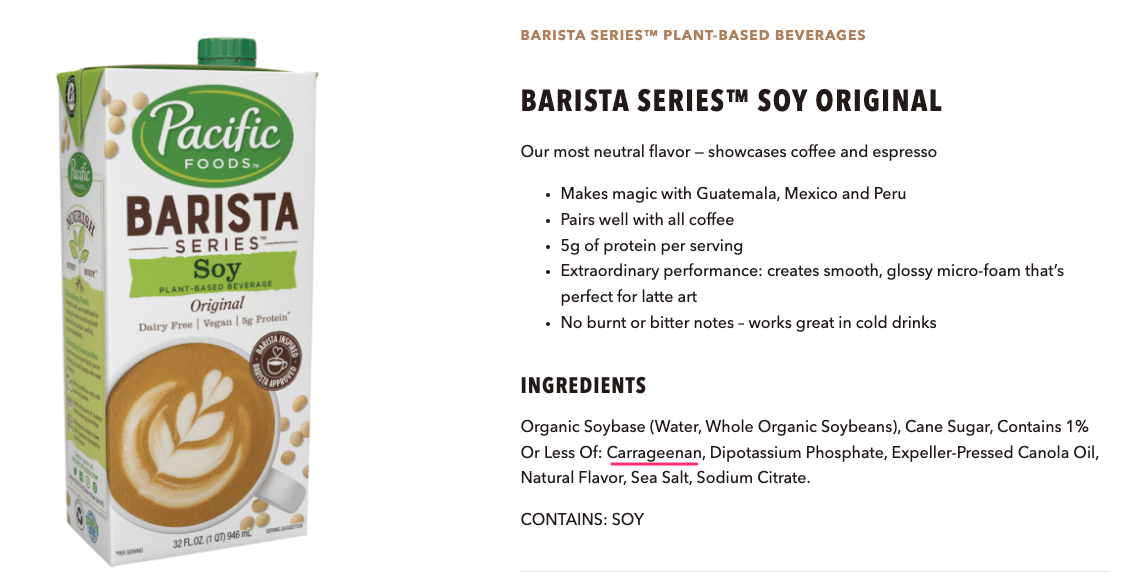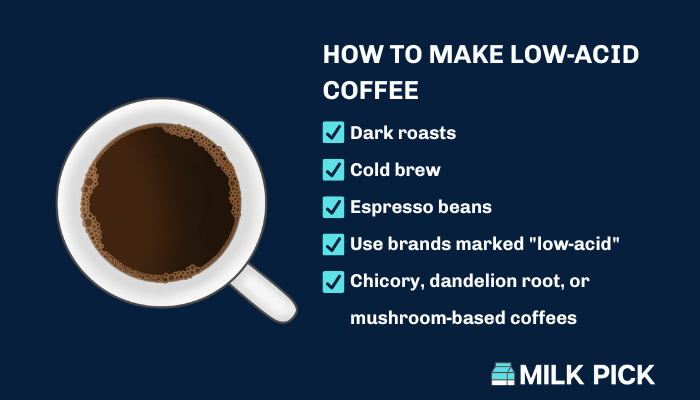Making coffee with soy milk can be challenging for coffee lovers who’ve recently switched to plant-based milk. Most are caught off guard when the soy milk curdles right after it’s added to coffee.
Soy milk will curdle in coffee because coffee is highly acidic. The proteins in soy milk react to coffee’s acidity and coagulate, causing the milk to curdle.
Although coffee’s acidity is the main cause, there are still other factors that could curdle the milk.
Read on to find out what causes soy milk to curdle and how to prevent it so that you can always enjoy a steaming cup of soy milk coffee whenever you want.
What Causes Soy Milk To Curdle In Coffee?
1. The Acidity Of The Coffee
There’s a significant PH difference between coffee and soy milk. Soy milk can be neutral or alkaline, while coffee has over 20 types of acids.
That’s why soy milk reacts to coffee when you mix the two. Soy proteins are sensitive to the change in PH and change their form - resulting in curdling.
2. High Temperature
Although soy proteins react to coffee’s acidity, the reaction happens faster when the coffee is hot.
High temperatures speed up the curdling process.
You’ll notice this if you try adding soy milk to cold coffee. The milk might take longer to curdle because the reaction is slower.
3. The Freshness Of The Soy Milk
There’s always the possibility that the soy milk might not be fresh. It will curdle if it's spoiled, even if it hasn’t expired.
Storage conditions affect how long soy milk lasts.
If soy milk is kept at a warm temperature, bacteria will grow, and the milk will slowly start to curdle. You might only notice the lumpy texture when you add it to coffee.
Homemade and refrigerated soy milk curdle faster when left out in the open, even in closed containers or packages.
Unfortunately, soy milk might still curdle when refrigerated.
It could happen if you drink straight from the carton and transfer bacteria from your mouth to the milk. Or if you fail to seal the container properly.
Related: Is Soy Milk Good For You?
How To Prevent Soy Milk From Curdling In Coffee
1. Use Barista Soy Milk (Caution!)
Barista soy milk is less likely to curdle in coffee.
Barista soy milk contains additives that interfere with the curdling process and is specifically made to be used in hot coffee.
Unfortunately, those additives can have potentially negative effects.
For instance, most barista milk uses inflammatory oils like canola oil, as well as ingredients like gellan gum, dipotassium phosphate, and sodium nitrate.
On top of that, they often contain up to two teaspoons of sugar.
I’ve looked far and wide, but I haven’t come across a barista soy milk that doesn’t contain any of these potentially harmful ingredients.
One popular barista soy milk option is Pacific Foods Barista Series Soy Original. It’s one of the few options you can buy in stores or online (at least in the U.S.)
However, the ingredient list has a major red flag—Carrageenan.

According to the ingredient list, it has less than 1% of Carrageenan. However, we always advise steering clear of this additive whenever possible. Long story short, it has been shown to cause gut health issues.
Check out this video to learn more:
The only brand that even comes close to being something we’d recommend is Alternative Dairy Co.
They make a barista soy milk that doesn’t have the best ingredients, but it’s free of ingredients like carrageenan and natural flavors, and has the lowest sugar count we could find.
Again, I wouldn’t recommend it, but it’s a much better option than most brands. The downside is it doesn’t seem to be available in the U.S.
Whether or not you use barista soy milk is a matter of preference, and depends on how you feel about additives.
At Milk Pick, we recommend choosing non-dairy milk with high quality, natural ingredients, and preferably no additives and emulsifiers.
2. Reduce The Acidity Of The Coffee
Here’s how you can lower the acidity of the coffee:
Switch Your Coffee
Different types of coffee have different levels of acidity.
According to coffeeresearch.org, the region the coffee beans grow in and the type of soil available will greatly influence its acidity.
For instance, most African coffees are highly acidic compared to Caribbean, Brazilian, and Hawaiian coffees.
Robusta coffee beans are also more acidic compared to Arabica coffee beans. You can easily switch to low-acid coffee with such knowledge.
Fortunately, the descriptions on the coffee can tell you its origin and acidity level.
Reading the descriptions before purchasing coffee will save you the trouble of later reducing the coffee’s acidity.
The degree to which coffee is roasted affects its acidity as well. Coffee undergoes chemical changes when roasted for a long time. That’s why dark roasts have less acidity.
Choose dark roasted blends over light or medium roasts whenever you want to use soy milk - for better results.
Coffee’s acidity is also affected by the brewing method. Research shows that cold brew coffee is less acidic than hot brew coffee.
Consider using the cold brewing method whenever you want to add soy milk to your coffee, especially in warm seasons. However, it requires patience because cold water slows down the extraction process.
We recommend soaking the coffee a day earlier if you want to cold brew. Otherwise, you’ll end up with tasteless coffee and lumpy soy milk if prepared in a hurry.

Add A Pinch Of Baking Soda
Baking soda is naturally alkaline with a PH of about 9. It can neutralize coffee’s acidity and prevent soy milk from curdling.
You just have to add a tiny pinch to the coffee before adding soy milk. And you’ll no longer be confronted by floating lumps of curdled milk.
However, too much baking soda will change the flavor of your coffee. So make sure the amount’s smaller than a peppercorn.
Baking soda (sodium bicarbonate) is also what keeps soy creamer from curdling in coffee.
Add A Pinch Of Salt
A tiny bit of salt can lower coffee’s acidity. Salt is also an excellent alternative to milk and sugar since it neutralizes coffee’s bitterness.
Remember to add salt to the coffee before pouring in the soy milk.
Increase The Calcium Content Of The Mixture
Calcium can neutralize coffee’s acidity levels and stop curdling.
Here’s how to increase the calcium content of the coffee-soy milk:
- Use hard water to brew the coffee: Unlike soft water, hard water is rich in calcium. So coffee brewed with hard water might be less acidic.
- Use fortified soy milk: Soy milk naturally contains about 40 milligrams of calcium. Fortified soy milk has a calcium supply of about 150 to 300 milligrams since it has added calcium.
- Use hard water to make homemade soy milk: Soaking soybeans in hard water can increase the soy milk’s calcium content to 120 milligrams. Check out the video below to see how to make soy milk.
3. Control The Temperature
As mentioned earlier, heat speeds up the reaction of the soy proteins and coffee’s acids.
Managing or balancing the soy milk and coffee temperature should give you better results.
You can adjust the temperature by:
Frothing The Soy Milk
Frothing creates foam which acts as a thermal insulator and increases the soy milk’s surface area.
It could interfere with the curdling process by slowing down the reaction. As a result, little to no curdling will occur.
Remember to froth the soy milk first before you mix it with coffee. Frothing can also sweeten the milk and improve its taste.
Cooling The Coffee
We’ve established that adding soy milk to a steaming cup of coffee could make it curdle.
Since hot coffee is part of the problem, you could let it cool down before adding the milk. If you don’t have the time to let it sit, you can add a bit of cold water to the coffee.
Although this method works for some people, you should avoid it if you dislike cold coffee.
Pouring The Soy Milk First
You can try pouring the milk first and then adding coffee slowly into the cup.
When you mix them in this order, the coffee gently heats the soy milk making it less likely to curdle.
Though, you should let the coffee cool down a little before attempting to mix it with the milk.
Not Overheating The Milk
Some people claim that heating soy milk can stop it from curdling. However, the milk will curdle faster if it’s overheated.
The trick is to heat the soy milk at about 55 to 60 degrees. Maintaining such temperatures can slow down chemical reactions and lessen the chances of the milk curdling.
4. Use Fresh Soy Milk
Properly store your soy milk to ensure it’s always fresh.
Homemade soy milk should be refrigerated immediately and consumed within 5 days.
Refrigerated (store-bought) soy milk also requires immediate refrigeration.
Use it within a week and finish it within a couple of days when opened.
Shelf-stable soy milk lasts longer, but you should be mindful of its expiry date. You can store the carton in a cool, dry place if unopened. However, you should refrigerate it and use it within 12 days once you open it.
Here are a few other tips to help keep your soy milk fresher for longer:
- Avoid drinking from the container or carton.
- Use tightly sealed containers to store the milk.
- Only open the packaging when you’re ready to use the milk.
- Consider freezing the milk to extend its shelf life.
- Always use clean containers and cups to avoid contaminating the milk.
- Don’t let open or homemade soy milk sit on the counter or pantry.
- Avoid storing soy milk in warm places.
- Always transfer the milk into a glass or mug first.
Additionally, you can smell or taste the soy milk. It will have a sour taste or aroma if it’s spoiled.
Testing the milk’s freshness will keep you from ruining your coffee.
Say Goodbye To Curdling!
There are several reasons why soy milk curdles in coffee.
The acidity and temperature of the coffee and even the brand and freshness of the soy milk can trigger curdling.
Making the perfect coffee with soy milk will take some time. You might need to experiment with the different methods we’ve listed before you get one that works for you.
The good news is that you can conveniently find baking soda, salt, hard water, and a frother in the kitchen.
Remember to go for low-acid coffee and be mindful of the coffee’s temperature. Also, try different soy milk brands in your experiments and always use fresh milk.
